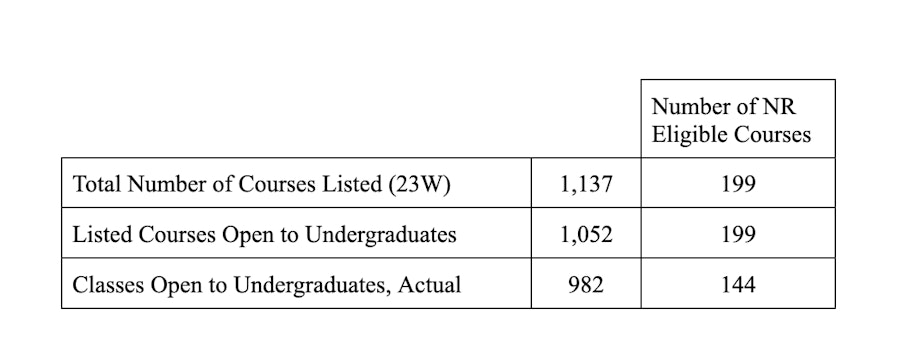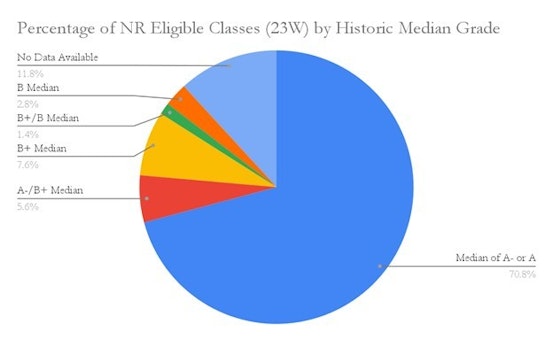One of the purportedly unique features of Dartmouth’s grading system is the ability to elect a non-recording option (NRO) for a class. Students can select a threshold for the lowest grade they are willing to receive in a class; if, upon completion of the term, they receive a grade lower than their limit (but still pass the class), an “NR” will appear on their transcript instead of the grade. This “NR” is not factored into GPA calculations.
Superficially, this makes a lot of sense. According to the registrar website, the NRO exists “to support and encourage students who would like to elect courses that may pose greater than usual academic risk.” What better way to foster intellectual curiosity and promote academic rigor than by providing a fallback for students who wish to challenge themselves and take a risk they might not have otherwise?
However, the NRO system has its flaws. For one, an NRO cannot be used for a major requirement and only one NRO class can be used for a minor. Even more significant, you cannot use an NRO to satisfy a distributive requirement.
A common use of an NRO is for when a student is cultivating their “intellectual curiosity” by branching out and taking a class in a department or field they don’t typically explore. Distributive requirements are in place to foster such broad and liberal academic engagement. Exploring a new field of study is not a simple feat. It inherently poses a “greater than usual academic risk” in itself! Despite this, the NRO seemingly fails to account for that.
Now what if it is about the grade itself and not about academic exploration? An overwhelming majority of the classes offered that are considered “NR eligible” already have median grades of either an A- or an A. Simultaneously, a large portion of the courses that typically have enforced or average medians of a B+ or lower are not eligible for the NRO.
To demonstrate this, I looked at the winter term (23W) course offerings listed by the registrar. Since the registrar does not provide this data to students, I had to manually calculate my numbers from the Winter Term 2023 Timetable of Class Meetings, which are as follows:

After accounting for courses appearing more than once on the timetable due to cross-listing and removing from consideration the graduate-level classes that are listed but not accessible for undergraduates, the numbers illustrate that only 14.7% of courses offered during 23W were actually eligible for the use of the NRO (or, 144 NR eligible classes out of 982 classes offered to undergraduates). For something intended to “support” students, this seems quite small.
Further investigation yielded another surprising result: 70.8% of NR eligible classes (102 out of 144) had a historic median of an A- or higher. These numbers are similar across 22F.
The rest of the breakdown is as follows: 11.8%, (17 out of 144) courses had no historic median information publicly available. 5.6% of courses (eight out of 144) had a median of A-/B+. These were not included in the 70.8% A- or higher median statistic. 11 courses (7.6%) had a B+ median, two courses (1.4%) had a median of a B+/B and four courses (2.8%) had a B median.

Courtesy of Matthew Capone
This leaves us with an interesting dilemma. Right out of the gate, you can’t elect to use an NRO for over 85% of classes offered. Moreover, despite the fact that the NRO is intended to mitigate the risk of receiving a poor grade in an academically rigorous course — as underscored by the registrar — just under 75% of all NR eligible classes do not have a low median grade.
I hesitate to call any class at Dartmouth not academically rigorous. I do truly believe that all courses are challenging in their own respects. However, I find it counterproductive that a tool to counter academic risk is barely usable, and when it is, it is scarcely allowed in instances of significant academic risk.
The statistics show us that you are more likely than not to receive an A or A- if you take a class that is NR eligible — even if you choose not to use the NR option at all.
Whether the solution is contingent upon an expansion of the NRO system, allowing for a greater number of courses to be NR eligible or something else entirely is not up to me. As a student, however, I can say this: unlike its prescribed intentions, the NRO is often discouraging and unsupportive. How this paradox still stands is beyond me. Administrative acknowledgement of the importance of the NRO system is not zero —the deadline to elect an NRO has been repeatedly pushed back in recent years on a case-by-case basis to allow students more flexibility during extenuating circumstances. Yet, this still fails to address the fundamental problem of the NRO’s hypocrisy: it still isn’t available in cases where it’s needed (namely, to be applied to classes which students are taking to satisfy a distributive requirement, higher-level classes that go beyond introductory material and classes that have historically lower medians of a B+ or below).
Methodology Note: [1] Graduate classes show up on the undergraduate 23W timetable—this term, there were 85 offered across a variety of different departments (e.g., MALS, CANB, GENE, ENGG, UNSG). [2] Accounting for cross-listed courses was especially difficult to determine, because not all courses were cross-listed once. For instance, a single class could be listed across four different total departments (appearing four times on the timetable, even though it was only one course). 62 courses were cross-listed twice (i.e., a single class listed by two different departments), 7 courses were cross-listed three times, and 1 course was cross-listed four times. [3] The NR option is exclusive to undergraduates.

